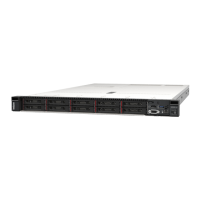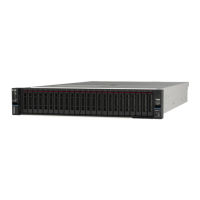b. Orient the Torx T30 nut under the anti-tilt wire bail; then, align the Torx T30 nut with the
socket at an angle as shown.
c.
Push the lower edge of the Torx T30 nut into the socket until it clicks into place. Make sure
the Torx T30 nut is secured under the four clips in the socket.
After you finish
1. Reinstall the PHM. See
“Install a processor and heat sink” on page 181.
2. Complete the parts replacement. See
“Complete the parts replacement” on page 246.
Demo video
Watch the procedure on YouTube
Hot-swap drive replacement
Use this information to remove and install a hot-swap drive. You can remove or install a hot-swap drive
without turning off the server, which helps you avoid significant interruption to the operation of the system.
Notes:
• The term “hot-swap drive” refers to all the supported types of hot-swap hard disk drives, hot-swap solid-
state drives, and hot-swap NVMe drives.
• Use any documentation that comes with the drive, and follow the instructions and those in this topic.
• The electromagnetic interference (EMI) integrity and cooling of the server are protected by having all drive
bays covered or occupied. The vacant bays are either covered by an EMI-protective panel or occupied by
drive fillers. When installing a drive, save any removed drive fillers for future use to cover vacant bays.
• To avoid damage to the drive connectors, ensure that the top cover is in place and fully closed whenever
you install or remove a drive.
Remove a 2.5/3.5-inch hot-swap drive
Use this information to remove a 2.5/3.5-inch hot-swap drive.
About this task
The following describes the information that you must consider for this task:
• Ensure that you have backed up data on your drive, especially if it is part of a RAID array.
– Before you make changes to drives, RAID adapters, or drive backplanes, back up all important data
that is stored on the drives.
– Before you remove any component of a RAID array, back up all RAID configuration information.
• If one or more NVMe drives are to be removed, it is recommended to disable them first in Safely Remove
Hardware and Eject Media (Windows) or filesystem (Linux). Log in to XClarity Controller and go to the
Storage menu to identify and locate the drive type and corresponding drive bay number. If the drive bay
numbers come with the term “NVMe”, it indicates that the installed drives are NVMe drives.
Attention:
• Read
“Installation Guidelines” on page 51 and “Safety inspection checklist” on page 52 to ensure that you
work safely.
Chapter 5. Hardware replacement procedures 115

